Robust Control Allocation for Space Inertial Sensor under Test Mass Release Phase with Overcritical Conditions
Abstract
:1. Introduction
2. System Dynamics Modeling with Uncertainty
2.1. Relative Dynamics of Spacecraft and Test Mass
- ♦
- ECI (EXEYEZE) frame: the Earth-centered inertial frame that is centered at the Earth.
- ♦
- SBF (OSXSYSZS) frame: the spacecraft body-fixed frame and its origin sits at the mass center of the spacecraft.
- ♦
- TBF (OTXTYTZT) frame: the test mass body-fixed frame and its origin sits at the mass center of the test mass.
- ♦
- IBF (OIXIYIZI) frame: the space inertial sensor body-fixed frame and its origin sits at the center of the space inertial sensor.
2.2. Electrostatic Force Model
2.3. Uncertainties in Control System
3. 6-DOF Robust Control Allocation
3.1. Weight Function Design
3.2. Robust Control Allocation Design
4. Simulations
5. Conclusions
Author Contributions
Funding
Institutional Review Board Statement
Informed Consent Statement
Data Availability Statement
Acknowledgments
Conflicts of Interest
References
- Kornfeld, R.P.; Arnold, B.W.; Gross, M.A.; Dahya, N.T.; Klipstein, W.M.; Gath, P.F.; Bettadpur, S. GRACE-FO: The gravity recovery and climate experiment follow-on mission. J. Spacecr. Rocket. 2019, 56, 931–951. [Google Scholar] [CrossRef]
- Canuto, E. Drag-free and attitude control for the GOCE satellite. Automatica 2008, 44, 1766–1780. [Google Scholar] [CrossRef] [Green Version]
- Papanikolaou, T.D.; Tsoulis, D. Assessment of Earth Gravity Field Models in the Medium to High Frequency Spectrum Based on GRACE and GOCE Dynamic Orbit Analysis. Geosciences 2018, 8, 441. [Google Scholar] [CrossRef] [Green Version]
- Chapman, P.; Zentgraf, P.; Jafry, Y. Drag-Free Control Design Including Attitude Transition for the STEP Mission; European Space Agency Publications; European Space Agency: Paris, France, 2003; Volume 516, pp. 551–558. [Google Scholar]
- Conklin, J.W.; Adams, M.; Bencze, W.J.; DeBra, D.B.; Green, G.; Herman, L.; Holmes, T.; Muhlfelder, B.; Parkinson, B.W.; Silbergleit, A.S.; et al. Precision attitude control of the Gravity Probe B satellite. Class. Quantum Gravity 2015, 32, 224015. [Google Scholar] [CrossRef]
- Zhang, J.; Wang, P.; Lian, X.; Lu, L.; Liu, W. A Predefined-Time Control for the Laser Acquisition in Space Gravitational Wave Detection Mission. Sensors 2022, 22, 7021. [Google Scholar] [CrossRef] [PubMed]
- Xiao, C.; Canuto, E.; Hong, W.; Zhou, Z.; Luo, J. Drag-free design based on Embedded Model Control for TianQin project. Acta Astronaut. 2022, 198, 482–494. [Google Scholar] [CrossRef]
- Chen, D.; Bai, Y.; Wang, C.; Wu, S.; Xiao, C.; Yu, J.; Zhou, Z. Bias Stability Investigation of a Triaxial Navigation-Compatible Accelerometer with an Electrostatic Spring. Sensors 2022, 22, 8102. [Google Scholar] [CrossRef] [PubMed]
- Bai, Y.; Li, Z.; Hu, M.; Liu, L.; Qu, S.; Tan, D.; Tu, H.; Wu, S.; Yin, H.; Li, H.; et al. Research and Development of Electrostatic Accelerometers for Space Science Missions at HUST. Sensors 2017, 17, 1943. [Google Scholar] [CrossRef]
- Wang, S.; Chen, L.; Wang, Y.; Zhou, Z.; Qi, K.; Wang, Z. A Space Inertial Sensor Ground Evaluation System for Non-Sensitive Axis Based on Torsion Pendulum. Appl. Sci. 2020, 10, 3090. [Google Scholar] [CrossRef]
- Weber, W.J.; Bortoluzzi, D.; Bosetti, P.; Consolini, G.; Dolesi, R.; Vitale, S. Application of LISA Gravitational Reference Sensor Hardware to Future Intersatellite Geodesy Missions. Remote Sens. 2022, 14, 3092. [Google Scholar] [CrossRef]
- Zanoni, C.; Bortoluzzi, D.; Conklin, J.W.; Köker, I.; Seutchat, B.; Vitale, S. Summary of the results of the LISA-Pathfinder Test Mass release. J. Phys. Conf. Ser. 2015, 610, 012022. [Google Scholar] [CrossRef]
- Bortoluzzi, D.; Vignotto, D.; Zambotti, A.; Armano, M.; Audley, H.; Baird, J.; Binetruy, P.; Born, M.; Castelli, E.; Cavalleri, A.; et al. In-flight testing of the injection of the LISA Pathfinder test mass into a geodesic. Adv. Space Res. 2020, 67, 504–520. [Google Scholar] [CrossRef]
- Inchauspé, H.; Olatunde, T.; Apple, S.; Parry, S.; Letson, B.; Turetta, N.; Mueller, G.; Wass, P.J.; Conklin, J.W. Numerical modeling and experimental demonstration of pulsed charge control for the space inertial sensor used in LISA. Phys. Rev. D 2020, 102, 042002. [Google Scholar] [CrossRef]
- Touboul, P.; Foulon, B.; Christophe, B.; Marque, J.P. CHAMP, GRACE, GOCE Instruments and Beyond. In Geodesy for Planet Earth: Proceedings of the 2009 IAG Symposium, Buenos Aires, Argentina, 31 August–4 September 2009; Springer: Berlin/Heidelberg, Germany, 2011; pp. 215–221. [Google Scholar] [CrossRef]
- Zahzam, N.; Christophe, B.; Lebat, V.; Hardy, E.; Huynh, P.-A.; Marquet, N.; Blanchard, C.; Bidel, Y.; Bresson, A.; Abrykosov, P.; et al. Hybrid Electrostatic–Atomic Accelerometer for Future Space Gravity Missions. Remote Sens. 2022, 14, 3273. [Google Scholar] [CrossRef]
- Wang, H.B.; Zhao, C.Y. Use CHAMP/STAR accelerometer data to evaluate atmospheric density models during solar maximum year. Acta Astron. Sin. 2008, 49, 168–178. [Google Scholar]
- Shen, Q.; Wang, D.; Zhu, S.; Poh, E.K. Robust Control Allocation for Spacecraft Attitude Tracking Under Actuator Faults. IEEE Trans. Control. Syst. Technol. 2016, 25, 1068–1075. [Google Scholar] [CrossRef]
- Hu, Q.; Li, B.; Wang, D.; Poh, E.K. Velocity-free fault-tolerant control allocation for flexible spacecraft with redundant thrusters. Int. J. Syst. Sci. 2015, 46, 976–992. [Google Scholar] [CrossRef]
- Hu, Q.; Li, B.; Zhang, A. Robust finite-time control allocation in spacecraft attitude stabilization under actuator misalignment. Nonlinear Dyn. 2013, 73, 53–71. [Google Scholar] [CrossRef]
- Cui, L.; Yang, Y. Disturbance Rejection and Robust Least-Squares Control Allocation in Flight Control System. J. Guid. Control. Dyn. 2011, 34, 1632–1643. [Google Scholar] [CrossRef]
- Huang, X.W.; Duan, G.R. Robust control allocation in attitude fault-tolerant control for combined spacecraft under measurement un-certainty. IEEE Access 2019, 7, 156191–156206. [Google Scholar] [CrossRef]
- Xu, Y. Robust fault-tolerant attitude control of spacecraft using hybrid actuators. Aircr. Eng. Aerosp. Technol. 2021, 94, 649–666. [Google Scholar] [CrossRef]
- De Almeida, F.A. Robust off-line control allocation. Aerosp. Sci. Technol. 2016, 52, 1–9. [Google Scholar] [CrossRef]
- Hu, Q.; Li, B.; Xiao, B.; Zhang, Y. Spacecraft Attitude Fault-Tolerant Control Based on Iterative Learning Observer and Control Allocation. In Control Allocation for Spacecraft Under Actuator Faults; Springer: Singapore, 2021; pp. 133–155. [Google Scholar] [CrossRef]
- Lian, X.; Zhang, J.; Chang, L.; Song, J.; Sun, J. Test mass capture for drag-free satellite based on RBF neural network adaptive sliding mode control. Adv. Space Res. 2021, 69, 1205–1219. [Google Scholar] [CrossRef]
- Shaul, D.N.A.; Araújo, H.M.; Rochester, G.K.; Schulte, M.; Sumner, T.J.; Trenkel, C.; Wass, P. Charge management for LISA and LISA Pathfinder. Int. J. Mod. Phys. D 2008, 17, 993–1003. [Google Scholar] [CrossRef]
- Weber, W.J.; Bortoluzzi, D.; Cavalleri, A.; Carbone, L.; Da Lio, M.; Dolesi, R.; Fontana, G.; Hoyle, C.D.; Hueller, M.; Vitale, S. Position sensors for flight testing of LISA drag-free control. Gravit.-Wave Detect. 2003, 4856, 31–42. [Google Scholar]
- Lian, X.; Zhang, J.; Lu, L.; Wang, J.; Liu, L.; Sun, J.; Sun, Y. Frequency Separation Control for Drag-Free Satellite With Frequency-Domain Constraints. IEEE Trans. Aerosp. Electron. Syst. 2021, 57, 4085–4096. [Google Scholar] [CrossRef]
- Boyd, S.; Boyd, S.P.; Vandenberghe, L. Convex Optimization; Cambridge University Press: Cambridge, UK, 2004. [Google Scholar]
- Wang, Y.; Wang, W. Quantum-Inspired Differential Evolution with Grey Wolf Optimizer for 0-1 Knapsack Problem. Mathematics 2021, 9, 1233. [Google Scholar] [CrossRef]
- Abdel-Basset, M.; Mohamed, R.; Mirjalili, S. A Binary Equilibrium Optimization Algorithm for 0–1 Knapsack Problems. Comput. Ind. Eng. 2021, 151, 106946. [Google Scholar] [CrossRef]
- Chebil, K.; Khemakhem, M. A dynamic programming algorithm for the Knapsack Problem with Setup. Comput. Oper. Res. 2015, 64, 40–50. [Google Scholar] [CrossRef]
- Schleicher, A.; Ziegler, T.; Schubert, R.; Brandt, N.; Bergner, P.; Johann, U.; Fichter, W.; Grzymisch, J. In-orbit performance of the LISA Pathfinder drag-free and attitude control system. CEAS Space J. 2018, 10, 471–485. [Google Scholar] [CrossRef]
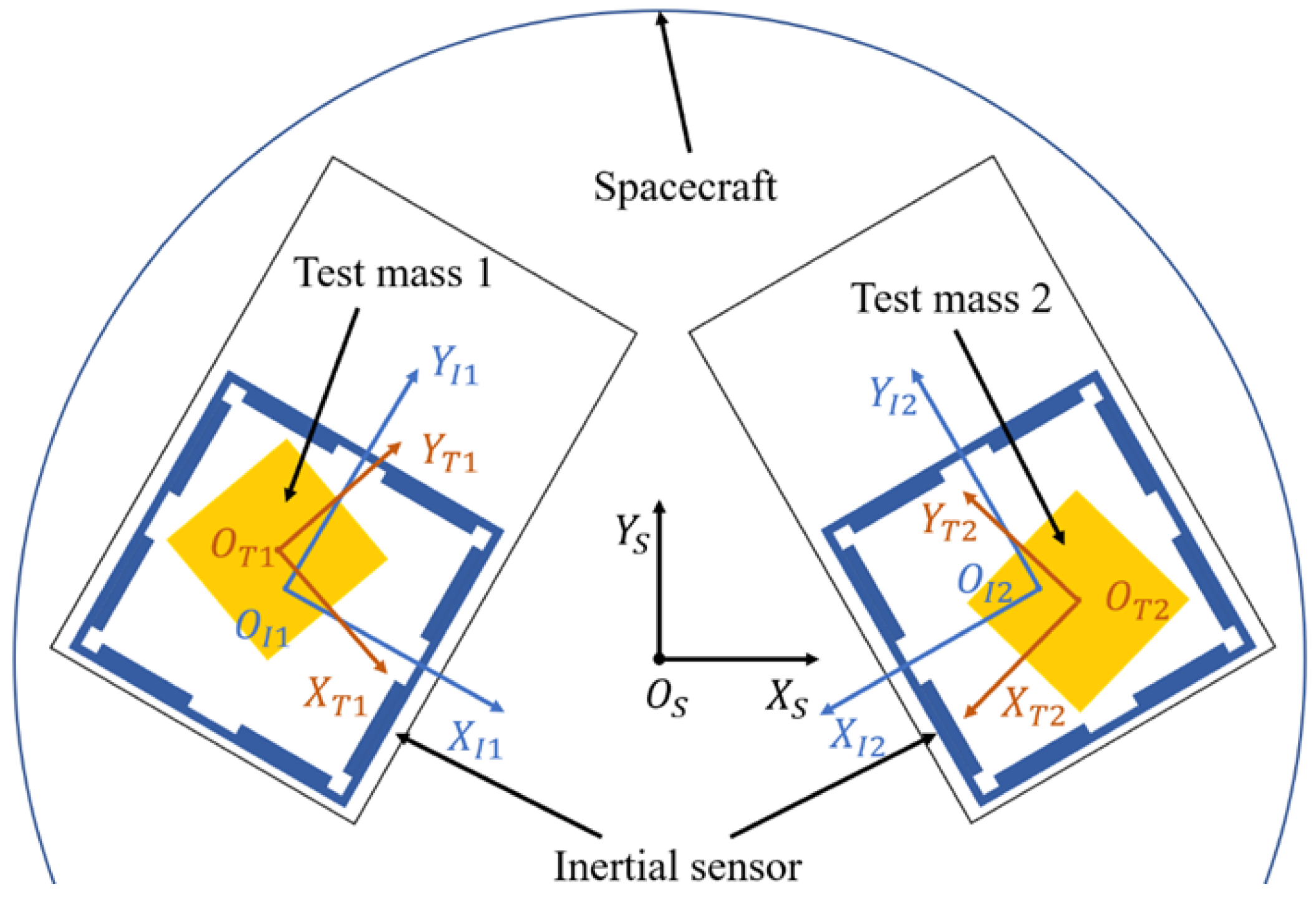
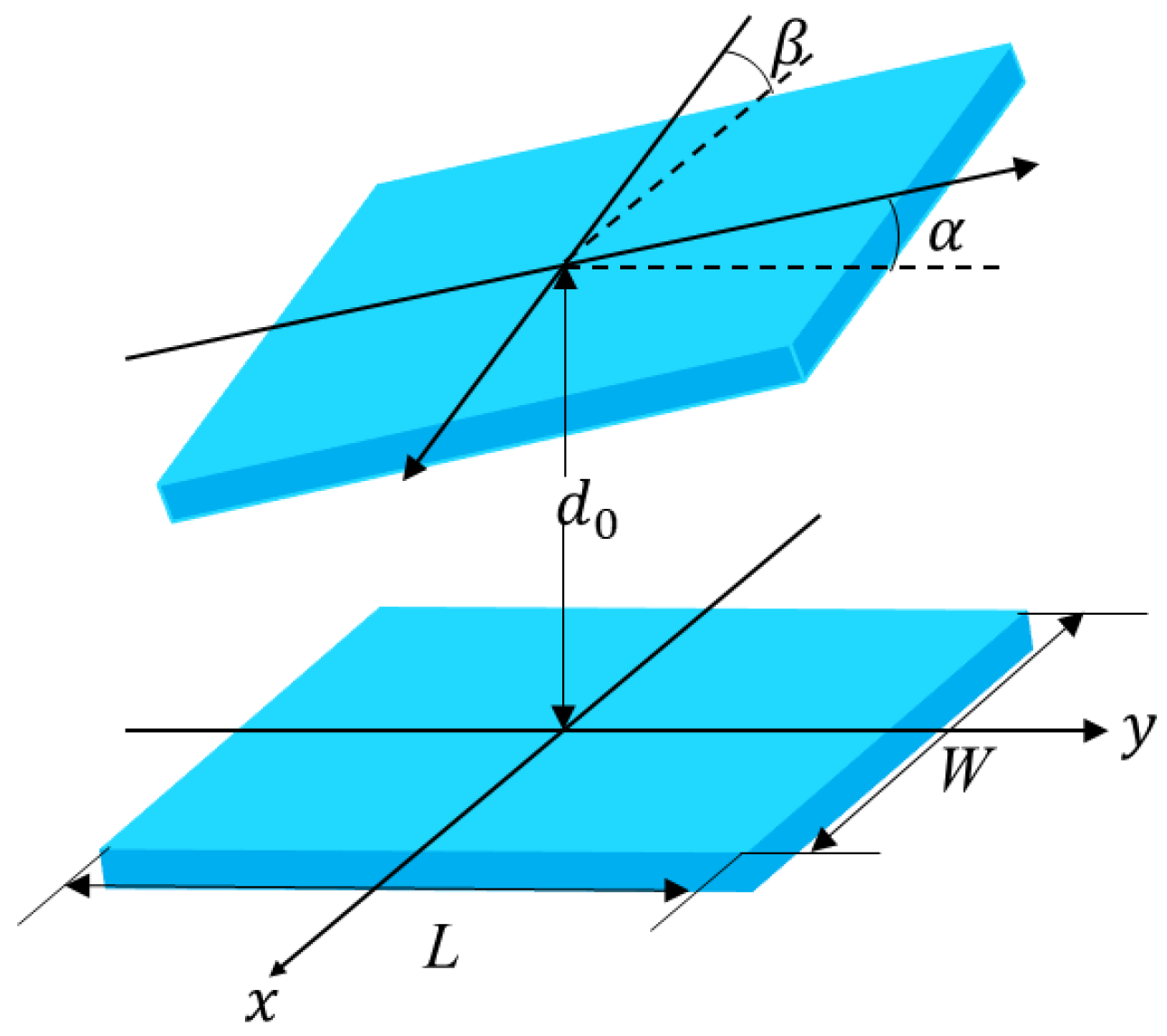



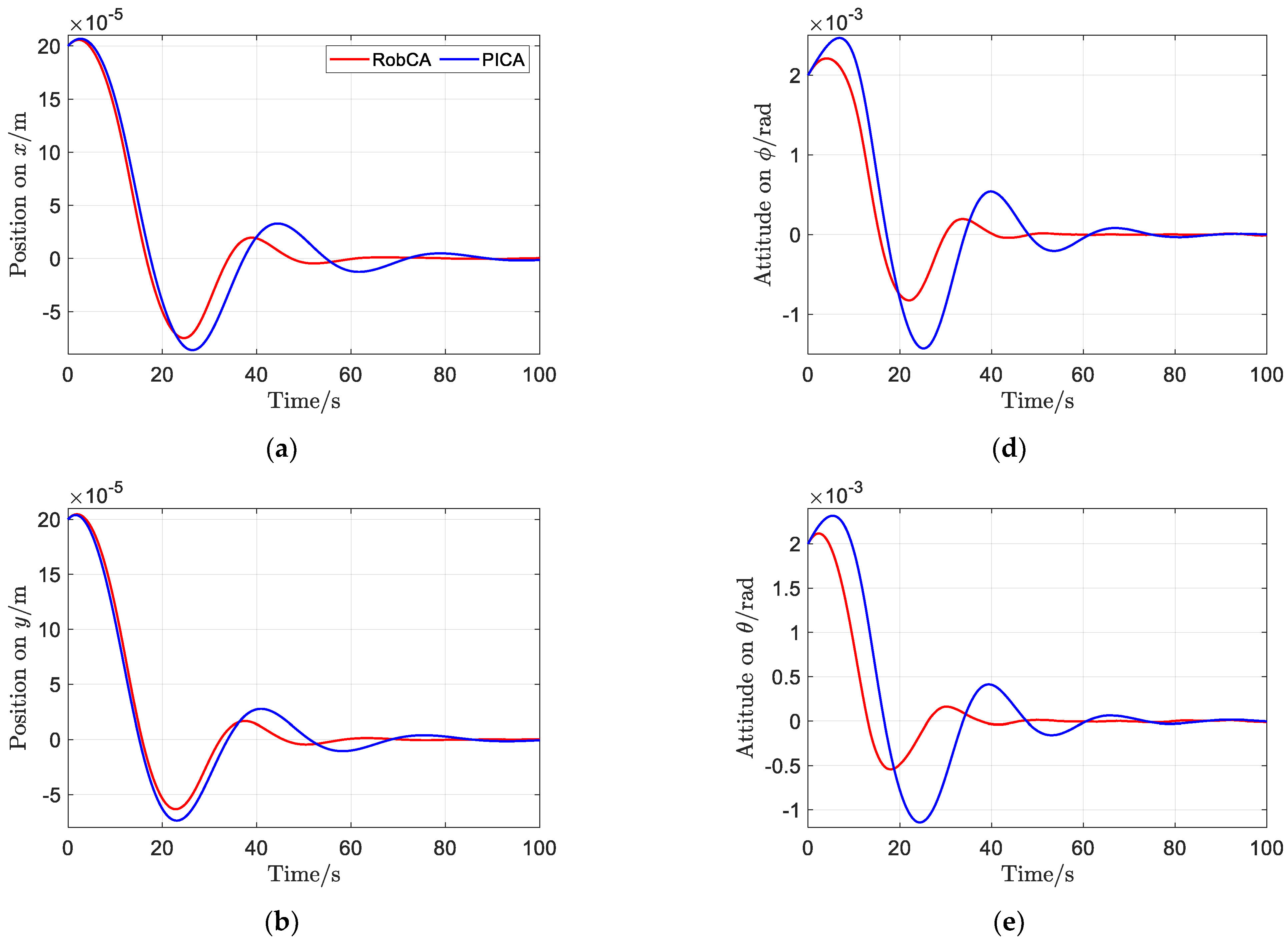
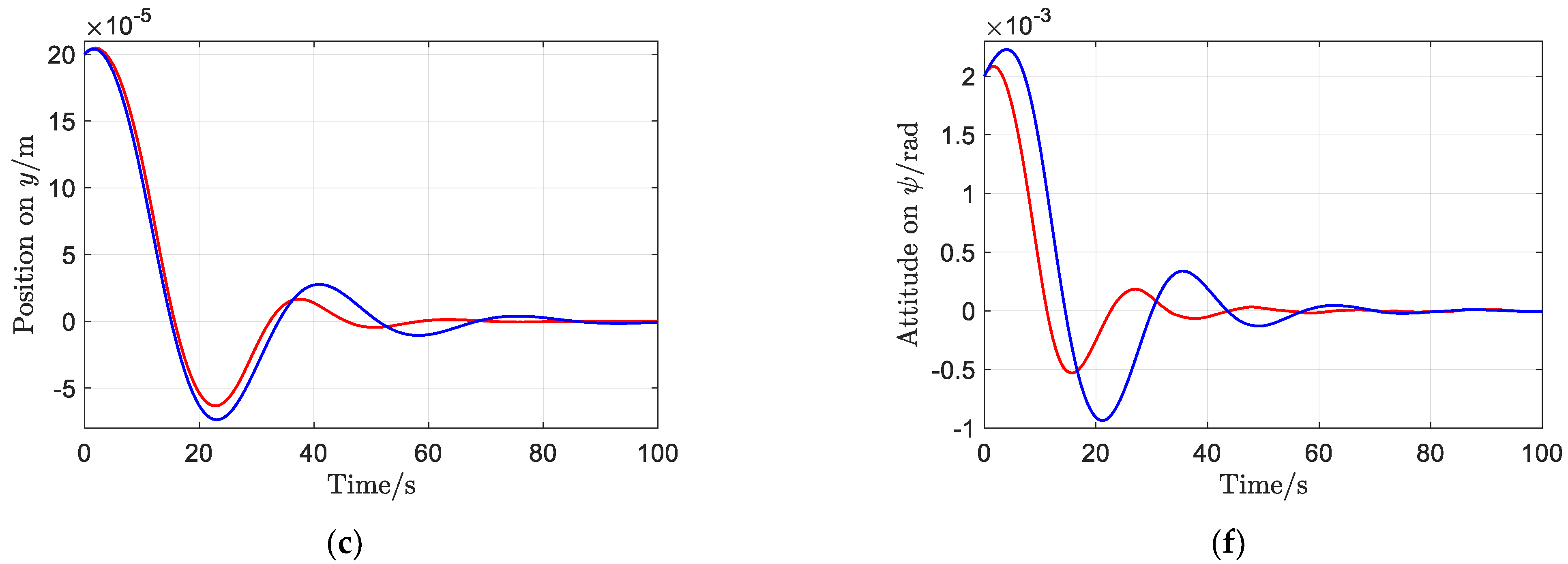

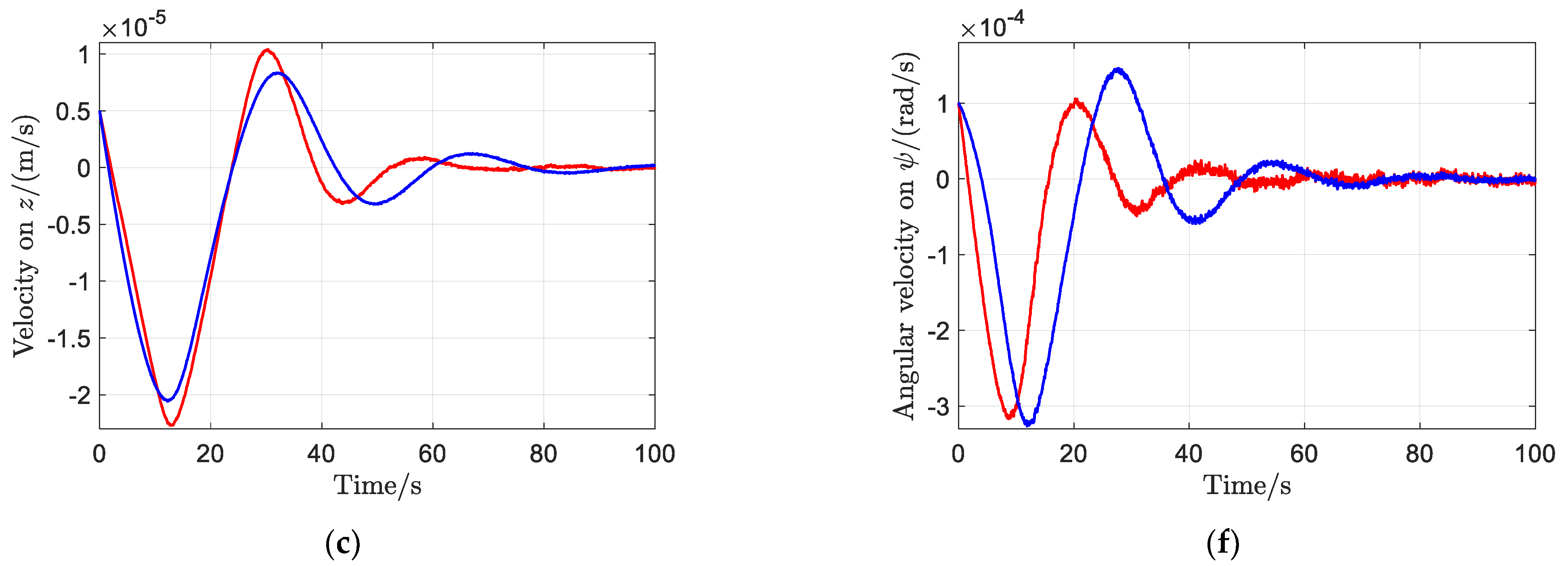

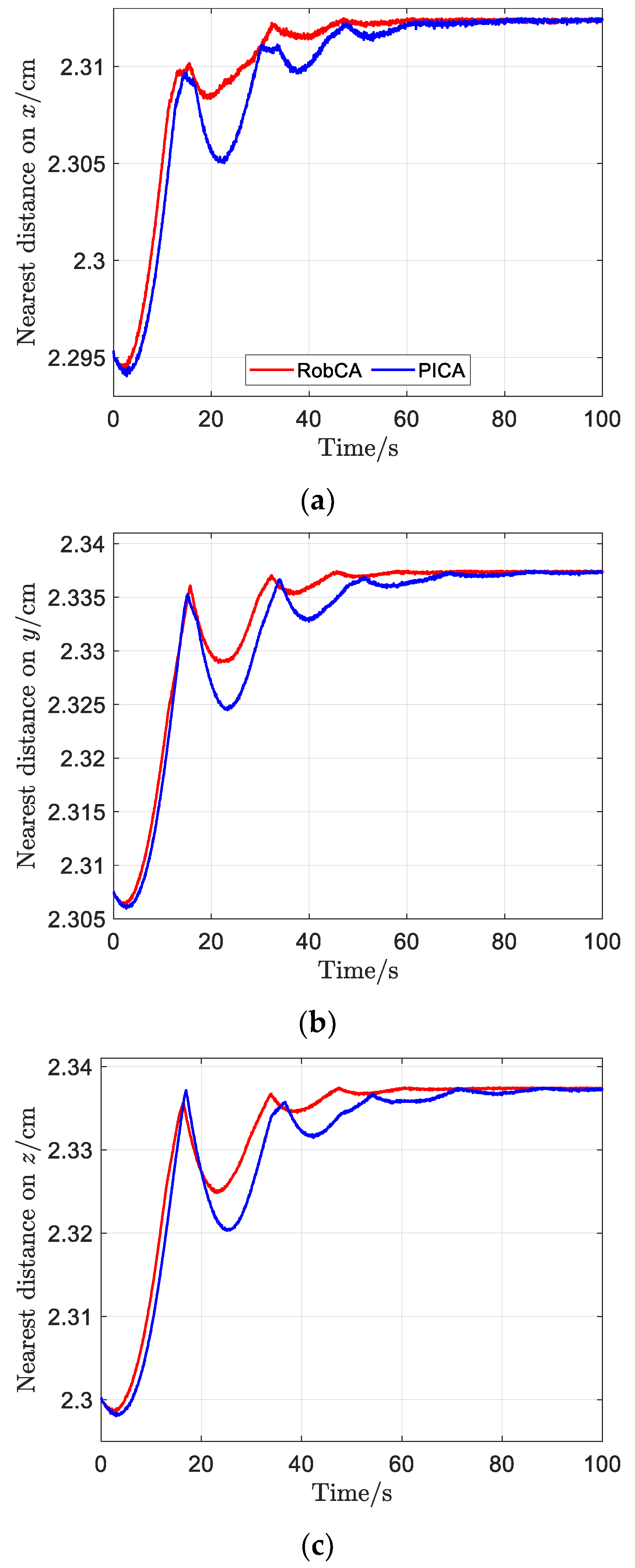
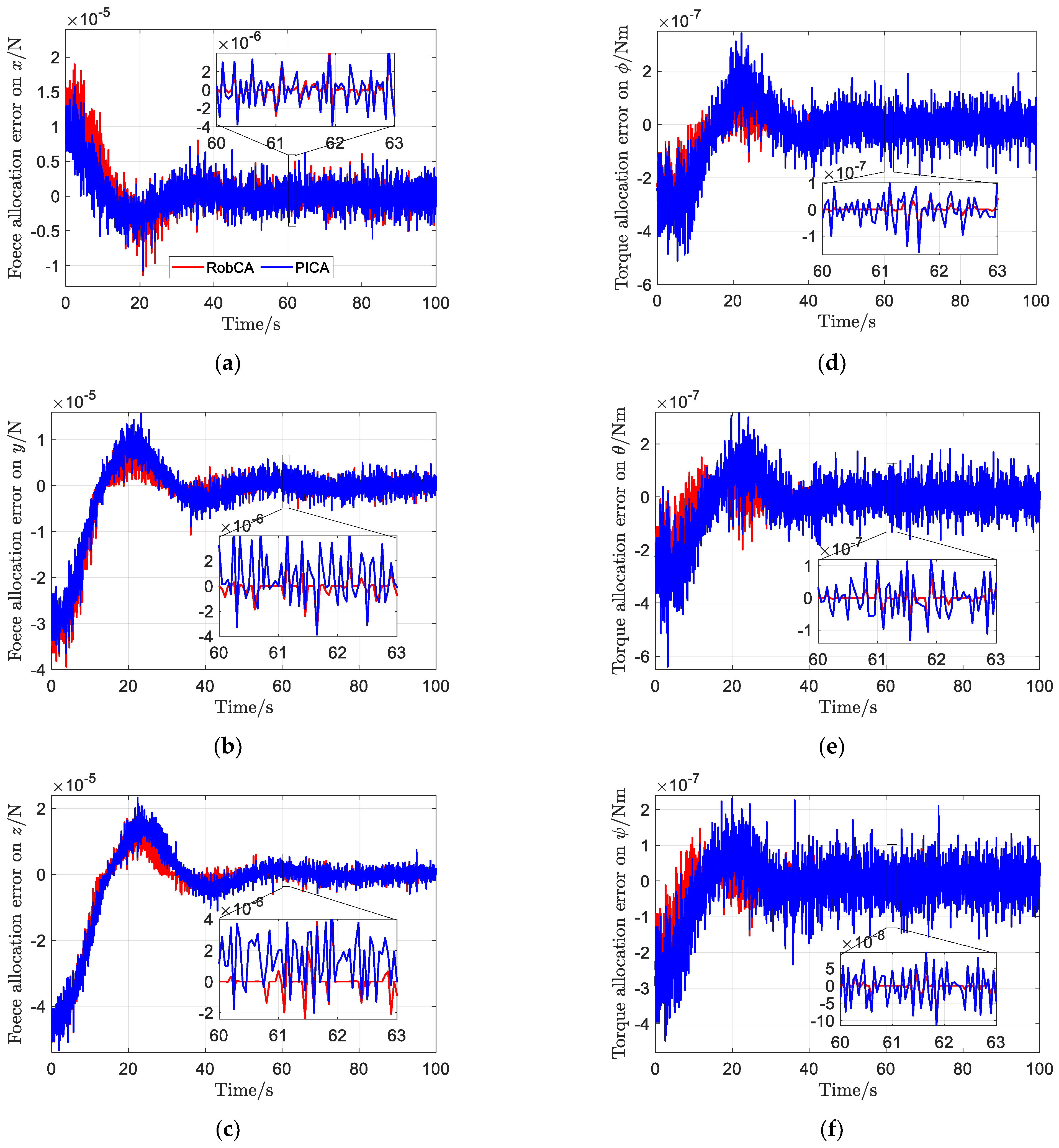
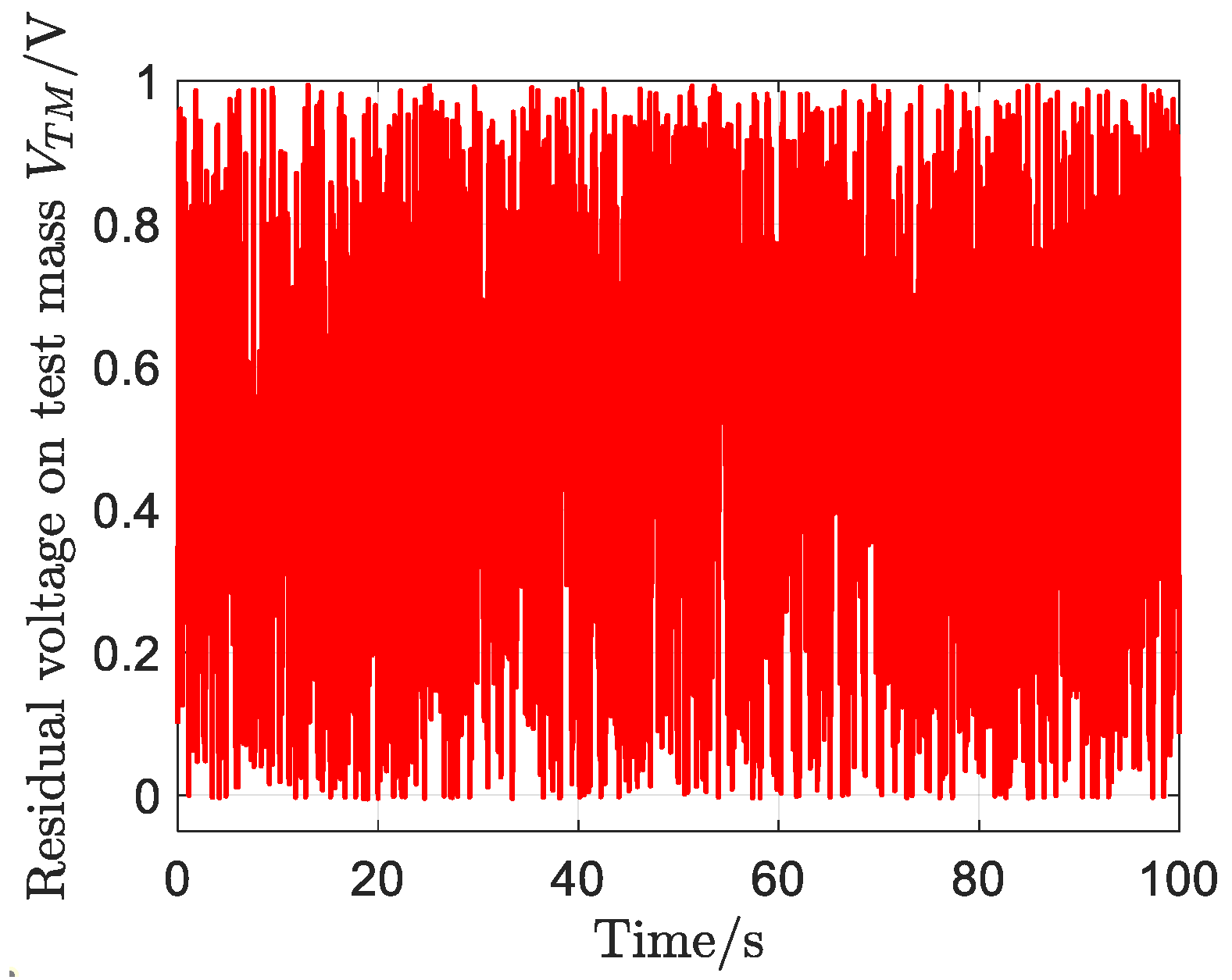
| Parameter | Value |
|---|---|
| Initial release position | |
| Initial release velocity | |
| Initial release attitude | |
| Initial release angular velocity | |
| Uncertainty of position measurement | |
| Uncertainty of attitude measurement | |
| Uncertainty of control voltage |
| Parameter | Value |
|---|---|
| Mass of test mass | |
| Inertia moments of test mass | |
| Position of the spacecraft in the frame ECI | |
| Position vector from the geometric left of space inertial sensor to spacecraft | |
| Orbital angular velocity of test mass | |
| Length of test mass | |
| Center distance of adjacent electrodes | |
| Area of each electrodes | |
| Ideal distance between test mass and electrodes | |
| Limit of electrodes voltage | |
| Controller parameters in position | |
| Controller parameters in attitude | |
| Constant η in Equation (13) | |
| Constant κ in Equation (20) |
Disclaimer/Publisher’s Note: The statements, opinions and data contained in all publications are solely those of the individual author(s) and contributor(s) and not of MDPI and/or the editor(s). MDPI and/or the editor(s) disclaim responsibility for any injury to people or property resulting from any ideas, methods, instructions or products referred to in the content. |
© 2023 by the authors. Licensee MDPI, Basel, Switzerland. This article is an open access article distributed under the terms and conditions of the Creative Commons Attribution (CC BY) license (https://creativecommons.org/licenses/by/4.0/).
Share and Cite
Zhang, J.; Zhang, Y.; Tao, W.; Lu, Z.; Lin, M. Robust Control Allocation for Space Inertial Sensor under Test Mass Release Phase with Overcritical Conditions. Sensors 2023, 23, 2881. https://doi.org/10.3390/s23062881
Zhang J, Zhang Y, Tao W, Lu Z, Lin M. Robust Control Allocation for Space Inertial Sensor under Test Mass Release Phase with Overcritical Conditions. Sensors. 2023; 23(6):2881. https://doi.org/10.3390/s23062881
Chicago/Turabian StyleZhang, Juzheng, Yu Zhang, Wenjian Tao, Zhenkun Lu, and Mingpei Lin. 2023. "Robust Control Allocation for Space Inertial Sensor under Test Mass Release Phase with Overcritical Conditions" Sensors 23, no. 6: 2881. https://doi.org/10.3390/s23062881




